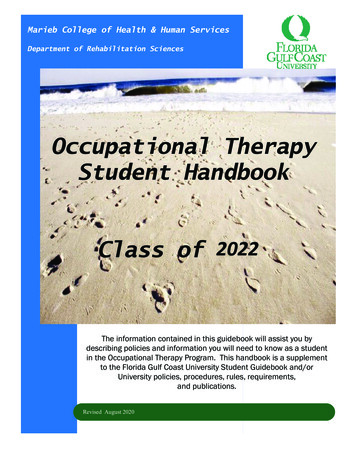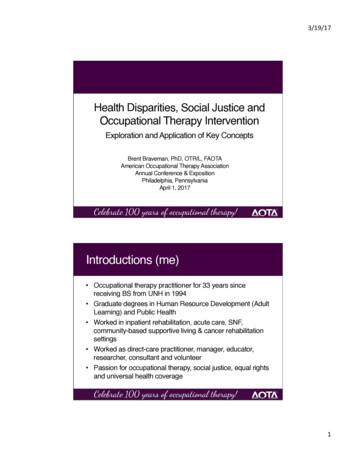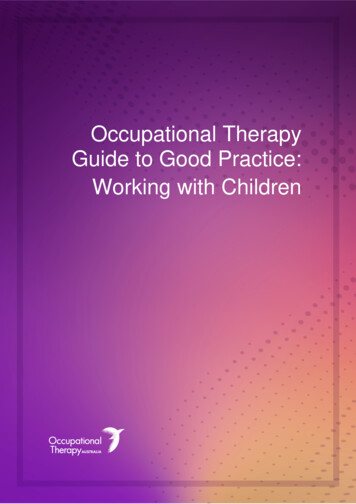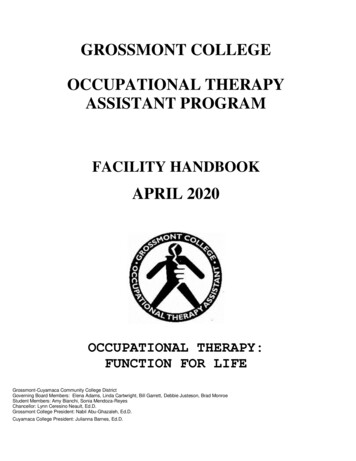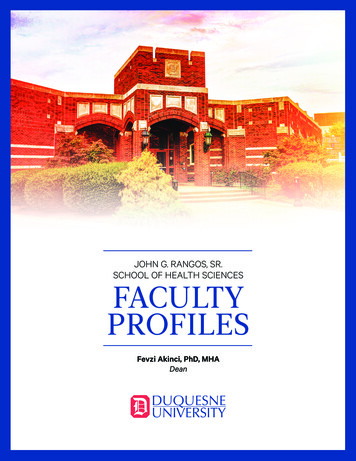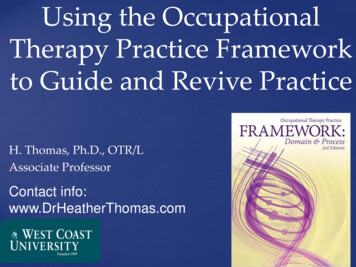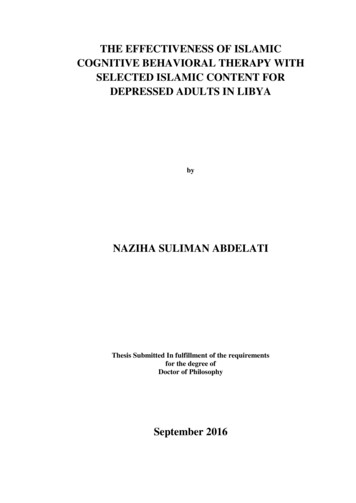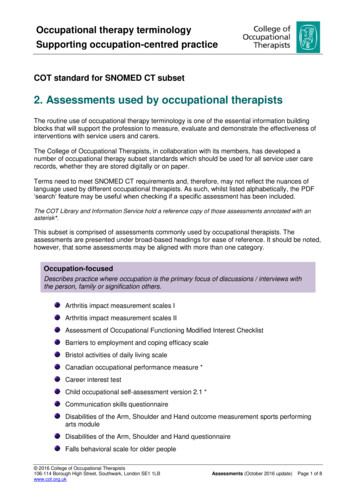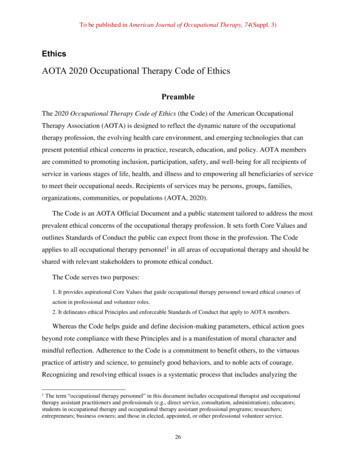
Transcription
To be published in American Journal of Occupational Therapy, 74(Suppl. 3)EthicsAOTA 2020 Occupational Therapy Code of EthicsPreambleThe 2020 Occupational Therapy Code of Ethics (the Code) of the American OccupationalTherapy Association (AOTA) is designed to reflect the dynamic nature of the occupationaltherapy profession, the evolving health care environment, and emerging technologies that canpresent potential ethical concerns in practice, research, education, and policy. AOTA membersare committed to promoting inclusion, participation, safety, and well-being for all recipients ofservice in various stages of life, health, and illness and to empowering all beneficiaries of serviceto meet their occupational needs. Recipients of services may be persons, groups, families,organizations, communities, or populations (AOTA, 2020).The Code is an AOTA Official Document and a public statement tailored to address the mostprevalent ethical concerns of the occupational therapy profession. It sets forth Core Values andoutlines Standards of Conduct the public can expect from those in the profession. The Codeapplies to all occupational therapy personnel1 in all areas of occupational therapy and should beshared with relevant stakeholders to promote ethical conduct.The Code serves two purposes:1. It provides aspirational Core Values that guide occupational therapy personnel toward ethical courses ofaction in professional and volunteer roles.2. It delineates ethical Principles and enforceable Standards of Conduct that apply to AOTA members.Whereas the Code helps guide and define decision-making parameters, ethical action goesbeyond rote compliance with these Principles and is a manifestation of moral character andmindful reflection. Adherence to the Code is a commitment to benefit others, to the virtuouspractice of artistry and science, to genuinely good behaviors, and to noble acts of courage.Recognizing and resolving ethical issues is a systematic process that includes analyzing theThe term “occupational therapy personnel” in this document includes occupational therapist and occupationaltherapy assistant practitioners and professionals (e.g., direct service, consultation, administration); educators;students in occupational therapy and occupational therapy assistant professional programs; researchers;entrepreneurs; business owners; and those in elected, appointed, or other professional volunteer service.126
To be published in American Journal of Occupational Therapy, 74(Suppl. 3)complex dynamics of situations, applying moral theories and weighing alternatives, makingreasoned decisions, taking action, and reflecting on outcomes. Occupational therapy personnelare expected to abide by the Principles and Standards of Conduct within this Code.The process for addressing ethics violations by AOTA members (and associate members,2where applicable) is outlined in the Code’s Enforcement Procedures (AOTA, 2019).Although many state regulatory boards incorporate the Code or similar language regardingethical behavior into regulations, the Code is meant to be a freestanding document that guidesethical dimensions of professional behavior, responsibility, practice, and decision making. ThisCode is not exhaustive; that is, the Principles and Standards of Conduct cannot address everypossible situation. Therefore, before making complex ethical decisions that require furtherexpertise, occupational therapy personnel should seek out resources to assist with resolvingconflicts and ethical issues not addressed in this document. Resources can include, but are notlimited to, ethics committees, organizational ethics officers or consultants, and the AOTA EthicsCommission. For a full list of AOTA ethics resources, please refer to the AOTA website ix A describes the revision process for the 2020 Code. Appendix B summarizes thehistory of the AOTA Occupational Therapy Code of Ethics.Core ValuesThe occupational therapy profession is grounded in seven long-standing Core Values: Altruism,Equality, Freedom, Justice, Dignity, Truth, and Prudence (AOTA, 1993). The seven Core Valuesprovide a foundation to guide occupational therapy personnel in their interactions with others.The following Core Values should be considered when determining the most ethical course ofaction (adapted from Core Values and Attitudes of Occupational Therapy Practice [AOTA,1993]):1. Altruism indicates demonstration of unselfish concern for the welfare of others. Occupational therapypersonnel reflect this concept in actions and attitudes of commitment, caring, dedication, responsiveness, andunderstanding.2For a definition of associate members, please see the AOTA Types-and-Fees.aspx26
To be published in American Journal of Occupational Therapy, 74(Suppl. 3)2. Equality indicates that all persons have fundamental human rights and the right to the same opportunities.Occupational therapy personnel demonstrate this value by maintaining an attitude of fairness and impartialityand treating all persons in a way that is free of bias. Personnel should recognize their own biases and respect allpersons, keeping in mind that others may have values, beliefs, or lifestyles that differ from their own. Equalityapplies to the professional arena as well as to recipients of occupational therapy services.3. Freedom indicates valuing each person’s right to exercise autonomy and demonstrate independence,initiative, and self-direction. A person’s occupations play a major role in their development of self-direction,initiative, interdependence, and ability to adapt and relate to the world. Occupational therapy personnel affirmthe autonomy of each individual to pursue goals that have personal and social meaning. Occupational therapypersonnel value the service recipient’s right and desire to guide interventions.4. Justice indicates that occupational therapy personnel provide occupational therapy services for all persons inneed of these services and maintain a goal-directed and objective relationship with recipients of service. Justiceplaces value on upholding moral and legal principles and on having knowledge of and respect for the legalrights of recipients of service. Occupational therapy personnel must understand and abide by local, state, andfederal laws governing professional practice. Justice is the pursuit of a state in which diverse communities areinclusive and are organized and structured so that all members can function, flourish, and live a satisfactory liferegardless of age, gender identity, sexual orientation, race, religion, origin, socioeconomic status, degree ofability, or any other status or attributes. Occupational therapy personnel, by virtue of the specific nature of thepractice of occupational therapy, have a vested interest in social justice: addressing unjust inequities that limitopportunities for participation in society (Ashe, 2016; Braveman & Bass-Haugen, 2009). They also exhibitattitudes and actions consistent with occupational justice: full inclusion in everyday meaningful occupations forpersons, groups, or populations (Scott et al., 2017).5. Dignity indicates the importance of valuing, promoting, and preserving the inherent worth and uniqueness ofeach person. This value includes respecting the person’s social and cultural heritage and life experiences.Exhibiting attitudes and actions of dignity requires occupational therapy personnel to act in ways consistentwith cultural sensitivity, humility, and agility.6. Truth indicates that occupational therapy personnel in all situations should be faithful to facts and reality.Truthfulness, or veracity, is demonstrated by being accountable, honest, forthright, accurate, and authentic inattitudes and actions. Occupational therapy personnel have an obligation to be truthful with themselves,recipients of service, colleagues, and society. Truth includes maintaining and upgrading professionalcompetence and being truthful in oral, written, and electronic communications.7. Prudence indicates the ability to govern and discipline oneself through the use of reason. To be prudent is tovalue judiciousness, discretion, vigilance, moderation, care, and circumspection in the management of one’sown affairs and to temper extremes, make judgments, and respond on the basis of intelligent reflection andrational thought. Prudence must be exercised in clinical and ethical reasoning, interactions with colleagues, andvolunteer roles.26
To be published in American Journal of Occupational Therapy, 74(Suppl. 3)PrinciplesThe Principles guide ethical decision making and inspire occupational therapy personnel to act inaccordance with the highest ideals. These Principles are not hierarchically organized. At times,conflicts between competing principles must be considered in order to make ethical decisions.These Principles may need to be carefully balanced and weighed according to professionalvalues, individual and cultural beliefs, and organizational policies.Principle 1. BeneficenceOccupational therapy personnel shall demonstrate a concern for the well-being and safetyof persons.The Principle of Beneficence includes all forms of action intended to benefit other persons. Theterm beneficence has historically indicated acts of mercy, kindness, and charity (Beauchamp &Childress, 2019). Beneficence requires taking action to benefit others—in other words, topromote good, to prevent harm, and to remove harm (Doherty & Purtilo, 2016). Examples ofBeneficence include protecting and defending the rights of others, preventing harm fromoccurring to others, removing conditions that will cause harm to others, offering services thatbenefit persons with disabilities, and acting to protect and remove persons from dangeroussituations (Beauchamp & Childress, 2019).Principle 2. NonmaleficenceOccupational therapy personnel shall refrain from actions that cause harm.The Principle of Nonmaleficence indicates that occupational therapy personnel must refrain fromcausing harm, injury, or wrongdoing to recipients of service. Whereas Beneficence requirestaking action to incur benefit, Nonmaleficence requires avoiding actions that cause harm(Beauchamp & Childress, 2019). The Principle of Nonmaleficence also includes an obligationnot to impose risks of harm even if the potential risk is without malicious or harmful intent. ThisPrinciple often is examined in the context of due care, which requires that the benefits of careoutweigh and justify the risks undertaken to achieve the goals of care (Beauchamp & Childress,2019). For example, an occupational therapy intervention might require the service recipient to26
To be published in American Journal of Occupational Therapy, 74(Suppl. 3)invest a great deal of time and perhaps even discomfort; however, the time and discomfort arejustified by potential long-term, evidence-based benefits of the treatment.Principle 3. AutonomyOccupational therapy personnel shall respect the right of the person to self-determination,privacy, confidentiality, and consent.The Principle of Autonomy expresses the concept that occupational therapy personnel have aduty to treat the client or service recipient according to their desires, within the bounds ofaccepted standards of care, and to protect their confidential information. Often, respect forAutonomy is referred to as the self-determination principle. Respecting the Autonomy of servicerecipients acknowledges their agency, including their right to their own views and opinions andtheir right to make choices in regard to their own care and based on their own values and beliefs(Beauchamp & Childress, 2019). For example, persons have the right to make a determinationregarding care decisions that directly affect their lives. In the event that a person lacks decisionmaking capacity, their Autonomy should be respected through the involvement of an authorizedagent or surrogate decision maker.Principle 4. JusticeOccupational therapy personnel shall promote equity, inclusion, and objectivity in theprovision of occupational therapy services.The Principle of Justice relates to the fair, equitable, and appropriate treatment of persons(Beauchamp & Childress, 2019). Occupational therapy personnel demonstrate attitudes andactions of respect, inclusion, and impartiality toward persons, groups, and populations withwhom they interact, regardless of age, gender identity, sexual orientation, race, religion, origin,socioeconomic status, degree of ability, or any other status or attributes. Occupational therapypersonnel also respect the applicable laws and standards related to their area of practice. Justicerequires the impartial consideration and consistent observance of policies to generate unbiaseddecisions. For example, occupational therapy personnel work to create and uphold a society in26
To be published in American Journal of Occupational Therapy, 74(Suppl. 3)which all persons have equitable opportunity for full inclusion in meaningful occupationalengagement as an essential component of their lives.Principle 5. VeracityOccupational therapy personnel shall provide comprehensive, accurate, and objectiveinformation when representing the profession.The Principle of Veracity refers to comprehensive, accurate, and objective transmission ofinformation and includes fostering understanding of such information. Veracity is based on thevirtues of truthfulness, candor, honesty, and respect owed to others (Beauchamp & Childress,2019). In communicating with others, occupational therapy personnel implicitly promise to betruthful and not deceptive. For example, when entering into a therapeutic or researchrelationship, the service recipient or research participant has a right to accurate information. Inaddition, transmission of information must include means to ensure that the recipient orparticipant understands the information provided.Principle 6. FidelityOccupational therapy personnel shall treat clients (persons, groups, or populations),colleagues, and other professionals with respect, fairness, discretion, and integrity.The Principle of Fidelity refers to the duty one has to keep a commitment once it is made(Veatch et al., 2015). This commitment refers to promises made between a provider and a client,as well as maintenance of respectful collegial and organizational relationships (Doherty &Purtilo, 2016). Professional relationships are greatly influenced by the complexity of theenvironment in which occupational therapy personnel work. For example, occupational therapypersonnel should consistently balance their duties to service recipients, students, researchparticipants, and other professionals, as well as to organizations that may influence decisionmaking and professional practice.Standards of Conduct26
To be published in American Journal of Occupational Therapy, 74(Suppl. 3)The AOTA Ethics Commission enforces the following Standards of Conduct under theEnforcement Procedures for the AOTA Occupational Therapy Code of Ethics (AOTA, 2019):Section1. Professional Integrity,Responsibility, andAccountability: Occupationaltherapy personnel maintainawareness and comply withAOTA policies and OfficialDocuments, current laws andregulations that are relevant tothe profession of occupationaltherapy, and employer policiesand procedures.Standards of Conduct for Occupational Therapy Personnel1A. Comply with current federal and state laws, state scope of practiceguidelines, and AOTA policies and Official Documents that apply to theprofession of occupational therapy. (Principle: Justice; key words: policy,procedures, rules, law, roles, scope of practice)1B. Abide by policies, procedures, and protocols when serving or acting onbehalf of a professional organization or employer to fully and accuratelyrepresent the organization’s official and authorized positions. (Principle:Fidelity; key words: policy, procedures, rules, law, roles, scope of practice)1C. Inform employers, employees, colleagues, students, and researchers ofapplicable policies, laws, and Official Documents. (Principle: Justice; keywords: policy, procedures, rules, law, roles, scope of practice)1D. Ensure transparency when participating in a business arrangement asowner, stockholder, partner, or employee. (Principle: Justice; key words:policy, procedures, rules, law, roles, scope of practice)1E. Respect the practices, competencies, roles, and responsibilities of one’sown and other professions to promote a collaborative environment reflectiveof interprofessional teams. (Principle: Fidelity; key words: policy, procedures,rules, law, roles, scope of practice, collaboration, service delivery)1F. Do not engage in illegal actions, whether directly or indirectly harmingstakeholders in occupational therapy practice. (Principle: Justice; key words:illegal, unethical practice)1G. Do not engage in actions that reduce the public’s trust in occupationaltherapy. (Principle: Fidelity; key words: illegal, unethical practice)1H. Report potential or known unethical or illegal actions in practice,education, or research to appropriate authorities. (Principle: Justice; keywords: illegal, unethical practice)1I. Report impaired practice to the appropriate authorities. (Principle:Nonmaleficence; key words: illegal, unethical practice)1J. Do not exploit human, financial, or material resources of employers forpersonal gain. (Principle: Fidelity; key words: exploitation, employee)1K. Do not exploit any relationship established as an occupational therapypractitioner, educator, or researcher to further one’s own physical, emotional,financial, political, or business interests. (Principle: Nonmaleficence; keywords: exploitation, academic, research)1L. Do not engage in conflicts of interest or conflicts of commitment inemployment, volunteer roles, or research. (Principle: Fidelity; key words:conflict of interest)26
To be published in American Journal of Occupational Therapy, 74(Suppl. 3)1M. Do not use one’s position (e.g., employee, consultant, volunteer) orknowledge gained from that position in such a manner as to give rise to real orperceived conflict of interest among the person, the employer, other AOTAmembers, or other organizations. (Principle: Fidelity; key words: conflict ofinterest)1N. Do not barter for services when there is the potential for exploitation andconflict of interest. (Principle: Nonmaleficence; key words: conflict ofinterest)2. Therapeutic Relationships:Occupational therapy personneldevelop therapeuticrelationships to promoteoccupational well-being in allpersons, groups, organizations,and society, regardless of age,gender identity, sexualorientation, race, religion,origin, socioeconomic status,degree of ability, or any otherstatus or attributes.1O. Conduct and disseminate research in accordance with currently acceptedethical guidelines and standards for the protection of research participants,including informed consent and disclosure of potential risks and benefits.(Principle: Beneficence; key words: research)2A. Respect and honor the expressed wishes of recipients of service.(Principle: Autonomy; key words: relationships, clients, service recipients)2B. Do not inflict harm or injury to recipients of occupational therapy services,students, research participants, or employees. (Principle: Nonmaleficence; keywords: relationships, clients, service recipients, students, research, employer,employee)2C. Do not threaten, manipulate, coerce, or deceive clients to promotecompliance with occupational therapy recommendations. (Principle:Autonomy; key words: relationships, clients, service recipients)2D. Do not engage in sexual activity with a recipient of service, including theclient’s family or significant other, while a professional relationship exists.(Principle: Nonmaleficence; key words: relationships, clients, servicerecipients, sex)2E. Do not accept gifts that would unduly influence the therapeuticrelationship or have the potential to blur professional boundaries, and adhereto employer policies when offered gifts. (Principle: Justice; key words:relationships, gifts, employer)2F. Establish a collaborative relationship with recipients of service andrelevant stakeholders to promote shared decision making. (Principle:Autonomy; key words: relationships, clients, service recipients, collaboration)2G. Do not abandon the service recipient, and attempt to facilitate appropriatetransitions when unable to provide services for any reason. (Principle:Nonmaleficence; key words: relationships, client, service recipients,abandonment)2H. Adhere to organizational policies when requesting an exemption fromservice to an individual or group because of self-identified conflict withpersonal, cultural, or religious values. (Principle: Fidelity; key words:relationships, client, service recipients, conflict, cultural, religious, values)2I. Do not engage in dual relationships or situations in which an occupationaltherapy professional or student is unable to maintain clear professionalboundaries or objectivity. (Principle: Nonmaleficence; key words:relationships, clients, service recipients, colleagues, professional boundaries,objectivity, social media)26
To be published in American Journal of Occupational Therapy, 74(Suppl. 3)2J. Proactively address workplace conflict that affects or can potentially affectprofessional relationships and the provision of services. (Principle: Fidelity;key words: relationships, conflict, clients, service recipients, colleagues)2K. Do not engage in any undue influences that may impair practice orcompromise the ability to safely and competently provide occupational therapyservices, education, or research. (Principle: Nonmaleficence; key words:relationships, colleagues, impair, safety, competence, client, service recipients,education, research)2L. Recognize and take appropriate action to remedy occupational therapypersonnel’s personal problems and limitations that might cause harm torecipients of service. (Principle: Nonmaleficence; key words: relationships,clients, service recipients, personal, safety)3. Documentation,Reimbursement, andFinancial Matters:Occupational therapy personnelmaintain complete, accurate,and timely records of all clientencounters.2M. Do not engage in actions or inactions that jeopardize the safety or wellbeing of others or team effectiveness. (Principle: Fidelity; key words:relationships, clients, service recipients, colleagues, safety, law, unethical,impaired, competence)3A. Bill and collect fees justly and legally in a manner that is fair, reasonable,and commensurate with services delivered. (Principle: Justice; key words:billing, fees)3B. Ensure that documentation for reimbursement purposes is done inaccordance with applicable laws, guidelines, and regulations. (Principle:Justice; key words: documentation, reimbursement, law)3C. Record and report in an accurate and timely manner and in accordancewith applicable regulations all information related to professional or academicdocumentation and activities. (Principle: Veracity; key words: documentation,timely, accurate, law, fraud)4. Service Delivery:Occupational therapy personnelstrive to deliver quality servicesthat are occupation based, clientcentered, safe, interactive,culturally sensitive, evidencebased, and consistent withoccupational therapy’s valuesand philosophies.3D. Do not follow arbitrary directives that compromise the rights or wellbeing of others, including unrealistic productivity expectations, fabrication,falsification, plagiarism of documentation, or inaccurate coding. (Principle:Nonmaleficence; key words: productivity, documentation, coding, fraud)4A. Respond to requests for occupational therapy services (e.g., referrals) in atimely manner as determined by law, regulation, or policy. (Principle: Justice;key words: occupational therapy process, referral, law)4B. Provide appropriate evaluation and a plan of intervention for recipients ofoccupational therapy services specific to their needs. (Principle: Beneficence;key words: occupational therapy process, evaluation, intervention)4C. Use, to the extent possible, evaluation, planning, intervention techniques,assessments, and therapeutic equipment that are evidence based, current, andwithin the recognized scope of occupational therapy practice. (Principle:Beneficence; key words: occupational therapy process, evaluation,intervention, evidence, scope of practice)4D. Obtain informed consent (written, verbal, electronic, or implied) afterdisclosing appropriate information and answering any questions posed by therecipient of service, qualified family member or caregiver, or researchparticipant to ensure voluntary participation. (Principle: Autonomy; keywords: occupational therapy process, informed consent)26
To be published in American Journal of Occupational Therapy, 74(Suppl. 3)4E. Fully disclose the benefits, risks, and potential outcomes of anyintervention; the occupational therapy personnel who will be providing theintervention; and any reasonable alternatives to the proposed intervention.(Principle: Autonomy; key words: occupational therapy process, intervention,communication, disclose, informed consent)4F. Describe the type and duration of occupational therapy services accuratelyin professional contracts, including the duties and responsibilities of allinvolved parties. (Principle: Veracity; key words: occupational therapyprocess, intervention, communication, disclose, informed consent, contracts)4G. Respect the client’s right to refuse occupational therapy servicestemporarily or permanently, even when that refusal has potential to result inpoor outcomes. (Principle: Autonomy; key words: occupational therapyprocess, refusal, intervention, service recipients)4H. Provide occupational therapy services, including education and training,that are within each practitioner’s level of competence and scope of practice.(Principle: Beneficence; key words: occupational therapy process, services,competence, scope of practice)4I. Reevaluate and reassess recipients of service in a timely manner todetermine whether goals are being achieved and whether intervention plansshould be revised. (Principle: Beneficence; key words: occupational therapyprocess, reevaluation, reassess, intervention)4J. Terminate occupational therapy services in collaboration with the servicerecipient or responsible party when the services are no longer beneficial.(Principle: Beneficence; key words: occupational therapy process, termination,collaboration)4K. Refer to other providers when indicated by the needs of the client.(Principle: Beneficence; key words: occupational therapy process, referral,service recipients)4L. Provide information and resources to address barriers to access for personsin need of occupational therapy services. (Principle: Justice; key words:beneficence, advocate, access)4M. Report systems and policies that are discriminatory or unfairly limit orprevent access to occupational therapy. (Principle: Justice; key words:discrimination, unfair, access, social justice)5. Professional Competence,Education, Supervision, andTraining: Occupationaltherapy personnel maintaincredentials, degrees, licenses,and other certifications todemonstrate their commitmentto develop and maintain4N. Provide professional services within the scope of occupational therapypractice during community-wide public health emergencies as directed byfederal, state, and local agencies. (Principle: Beneficence; key words:disasters, emergency)5A. Hold requisite credentials for the occupational therapy services oneprovides in academic, research, physical, or virtual work settings. (Principle:Justice; key words: credentials, competence)5B. Represent credentials, qualifications, education, experience, training,roles, duties, competence, contributions, and findings accurately in all forms ofcommunication. (Principle: Veracity; key words: credentials, competence)26
To be published in American Journal of Occupational Therapy, 74(Suppl. 3)competent, evidence-basedpractice.5C. Take steps (e.g., professional development, research, supervision, training)to ensure proficiency, use careful judgment, and weigh potential for harmwhen generally recognized standards do not exist in emerging technology orareas of practice. (Principle: Beneficence; key words: credentials, competence)5D. Maintain competence by ongoing participation in professionaldevelopment relevant to one’s practice area. (Principle: Beneficence; keywords: credentials, competence)5E. Take action to resolve incompetent, disruptive, unethical, illegal, orimpaired practice in self or others. (Principle: Fidelity; key words:competence, law)5F. Ensure that all duties delegated to other occupational therapy personnel arecongruent with their credentials, qualifications, experience, competencies, andscope of practice with respect to service delivery, supervision, fieldworkeducation, and research. (Principle: Beneficence; key words: supervisor,fieldwork, supervision, student)5G. Provide appropriate supervision in accordance with AOTA OfficialDocuments and relevant laws, regulations, policies, procedures, standards, andguidelines. (Principle: Justice; key words: supervisor, fieldwork, supervision,student)5H. Be honest, fair, accurate, respectful, and timely in gathering and reportingfact-based information regarding employee job performance and studentperformance. (Principle: Veracity; key words: supervisor, supervision,fieldwork, performance)5I. Do not participate in any action resulting in unauthorized access toeducational content or exams, screening and assessment tools, websites, andother copyrighted information, including but not limited to plagiarism,violation of copyright laws, and illegal sharing of resources in any form.(Principle: Justice; key words: plagiarize, student, copyright, cheating)6. Communication: Whetherin written, verbal, electronic, orvirtual communication,occupati
are expected to abide by the Principles and Standards of Conduct within this Code. The process for addressing ethics violations by AOTA members (and associate members,2 where applicable) is outlined in the Code's Enforcement Procedures (AOTA, 2019). Although many state regulatory boards incorporate the Code or similar language regarding
